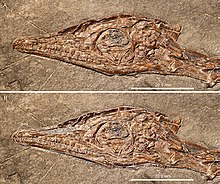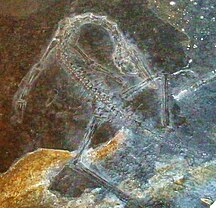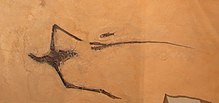Macrocnemus
| Macrocnemus Temporal range:Middle Triassic,
| |
|---|---|

| |
| Various specimens ofMacrocnemusfromMonte San Giorgioin Switzerland. | |
| Scientific classification | |
| Domain: | Eukaryota |
| Kingdom: | Animalia |
| Phylum: | Chordata |
| Class: | Reptilia |
| Clade: | Archosauromorpha |
| Clade: | †Tanysauria |
| Family: | †Tanystropheidae |
| Genus: | †Macrocnemus Nopcsa,1931 |
| Species | |
| |
Macrocnemusis anextinctgenusofarchosauromorphreptileknown from theMiddle Triassic(LateAnisiantoLadinian) ofEuropeandChina.Macrocnemusis a member of theTanystropheidaefamilyand includes threespecies.Macrocnemus bassanii,the first species to be named and described, is known from theBesano Formationand adjacent paleontological sites in theItalianandSwiss Alps.[1]Macrocnemus fuyuanensis,on the other hand, is known from theZhuganpo Formationin southern China.[2]A third species,Macrocnemus obristi,is known from theProsanto FormationofSwitzerlandand is characterized by gracile limbs.[3]The nameMacrocnemusis Greek for "longtibia".
Description
[edit]
Macrocnemusis known from multiple specimens, most belonging toM. bassanii.[4]It is a small reptile measuring 1.1–1.2 metres (3.6–3.9 ft) long.[5]Macrocnemuspossessed at least 52 or 53 caudal vertebrae. Like many other early archosauromorphs,Macrocnemushad a small and low head on the end of a thin neck containing vertebrae with low neural spines and long cervical ribs. Many archosauromorphs with these features have been grouped within theorderProtorosauria,although it is debatable whether this order is valid.[6]Features that are common to most "protorosaurs" likeMacrocnemusinclude the ankle having a hooked fifth metatarsal attached to elongated limb elements, with tarsal elements with well-ossified proximal and distal ends. Unlike inTanystropheus,digit V of the proximal phalanx ofMacrocnemusis shorter than the other digits.
Species
[edit]M. bassanii
[edit]
Macrocnemus bassaniiis the most well-known and numerous species ofMacrocnemus.Although theholotypespecimen of this species was destroyed duringWorld War II,a cast of the specimen (MSNM14624, or alternatively PIMUZ T 2473) survived.[7]

Numerous complete or partial specimens ofM. bassannihoused at PIMUZ (Paläontologisches Institut und Museum derUniversität Zürich) include A III/208, T 1534, T 2470, T 2472, T 2474 through T 2477, T 2809, T 2812 through T 2816, T 4822, and T 4355.[4][7]

The smallest specimen of this species is MSNM BES SC111, which is believed to be a juvenile about 30 centimeters long. The largest specimens were about 90 centimeters long.
M. fuyuanensis
[edit]Macrocnemus fuyuanensiswas discovered at the Yunnan Province, southwestern China from the marine of the Triassic. More specially, it is known from the Zhuganpo Formation (formerly Zhuganpo Member of the Falang Formation).[8]This species in known from two nearly complete specimens,IVPPV15001 (the holotype specimen) and GMPKU-P-3001. The main features that set this species apart fromM. bassaniiinclude the presence of 17 or 18 dorsal vertebrae, a humerus which is longer than the radius, and a femur which is longer than the tibia. The front of the skull also differs compared toM. bassanii.According to Olivier Rieppleet al,“a large, plate-like lacrimal is located in front of the tall, columnar prefrontal that defines the anterior margin of the orbit. A longitudinally oriented nasal groove extends along the anterior two-thirds of the snout, accommodating the external naris at its anterior part”. This species is also larger thanM. bassanii.[2]
In 2017, a new specimen ofMacrocnemusfrom the Besano Formation was described. This specimen, PIMUZ T 1559, possessed a long humerus, similar to that ofM. fuyuanensis.It also differed from M. bassanii in the construction of its interclavicle. However, the interclavicles of the Chinese specimens are difficult to observe, and thus it is uncertain whether this European specimen is truly a member ofM. fuyuanensis.Its describers placed it as "Macrocnemusaff.M. fuyuanensis",indicating its close relations to this species.[7]

M. obristi
[edit]Macrocnemus obristiwas discovered by Christian Obrist during an excavation from the Upper Prosanto Formation, which is dated to the middle Triassic. It is known from two specimens, PIMUZ A/III 1467 (the holotype, consisting of a complete articulated tail, legs, and pelvic region) and PIMUZ A/III 722 (an isolated righttarsus). It is noticeably characterized by its gracile limb elements (including slender metatarsals) and a tibia which is 20% longer than the femur. Preserved soft tissue has also been found in the pelvic girdle ofM. obristi'sholotype.[3]
Paleobiology
[edit]Some features of the limbs imply thatMacrocnemuslived in terrestrial habitats and was capable of rapid bipedal movement.[4]MacrocnemusandTanystropheusare among the most common "protorosaur" genera found in middle Triassic marine sediments. The presence of bothMacrocnemusandTanystropheusin both Switzerland and southwestern China suggest that the fauna of the western and eastern Tethyan realms was similar during the Middle and early Late Triassic.[2]
Classification
[edit]In 1970 Romer classifiedMacrocnemusas alepidosaurrelated to modernlizardsandtuataras,but in 1988 Carroll reclassified it as a member of Protorosauria. Other "protorosaurs" includeProtorosaurusandTanystropheus.Protorosaurs may not form a validmonophyleticclade according to some studies, which place tanystropheids as more derived archosauromorphs than other "protorosaurs".Macrocnemusis believed to be an early member of the tanystropheid family, as it shares many small skeletal features withTanystropheusyet lacks the very elongated neck of that genus and other derived tanystropheids.[6]
References
[edit]- ^Nopcsa, Ferenc (1930). "Notizen über Macrochemus bassanii nov. gen. et spec".Centralblatt für Mineralogie, Geologie und Paläontologie, Abteilung B.7:252–255.
- ^abcJiang, Da-Yong; Rieppel, Olivier; Fraser, Nicholas C; Motani, Ryosuke; Hao, Wei-Cheng; Tintori, Andrea; Sun, Yuan-Lin; Sun, Zuo-Yu (2011). "New information on the protorosaurian reptile Macrocnemus fuyuanensis Li et al., 2007, from the Middle/Upper Triassic of Yunnan, China".Journal of Vertebrate Paleontology.31(6): 1230–1237.Bibcode:2011JVPal..31.1230J.doi:10.1080/02724634.2011.610853.S2CID131615836.
- ^abFraser, Nicholas; Furrer, Heinz (2013)."A new species of Macrocnemus from the Middle Triassic of the eastern Swiss Alps".Swiss Journal of Geosciences.106(2): 199–206.doi:10.1007/s00015-013-0137-5.S2CID140702183.
- ^abcRieppel, Olivier (1989). "The Hind Limb of Macrocnemus bassanii (Nopcsa) (Reptilia, Diapsida): Deverlopment and Functional Anatomy".Journal of Vertebrate Paleontology.9(4): 373–387.Bibcode:1989JVPal...9..373R.doi:10.1080/02724634.1989.10011771.JSTOR4523279.
- ^Rieppel, O. (2019).Mesozoic Sea Dragons: Triassic Marine Life from the Ancient Tropical Lagoon of Monte San Giorgio.Indiana University Press. p. 175.doi:10.2307/j.ctvd58t86.ISBN978-0253040114.
- ^abEzcurra, Martín D. (2016-04-28)."The phylogenetic relationships of basal archosauromorphs, with an emphasis on the systematics of proterosuchian archosauriforms".PeerJ.4:e1778.doi:10.7717/peerj.1778.ISSN2167-8359.PMC4860341.PMID27162705.
- ^abcJaquier, Vivien P.; Fraser, Nicholas C.; Furrer, Heinz; Scheyer, Torsten M. (2017)."Osteology of a New Specimen of Macrocnemus aff. M. fuyuanensis (Archosauromorpha, Protorosauria) from the Middle Triassic of Europe: Potential Implications for Species Recognition and Paleogeography of Tanystropheid Protorosaurs".Frontiers in Earth Science.5:91.Bibcode:2017FrEaS...5...91J.doi:10.3389/feart.2017.00091.ISSN2296-6463.
- ^Fraser, Nicholas C; Rieppel, Olivier; Chun, LI (2013). "A Long-Snouted Protorosaur from the Middle Triassic of Southern China".Journal of Vertebrate Paleontology.33(5): 1120–1126.Bibcode:2013JVPal..33.1120F.doi:10.1080/02724634.2013.764310.JSTOR42568629.S2CID83521468.



